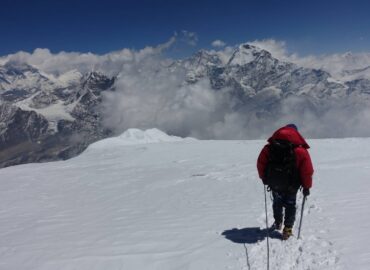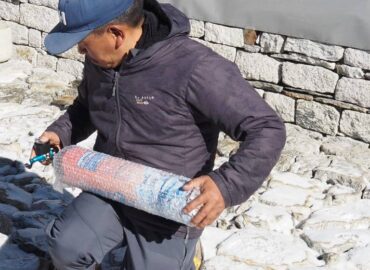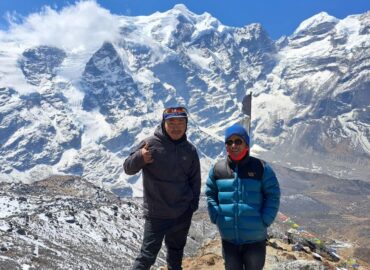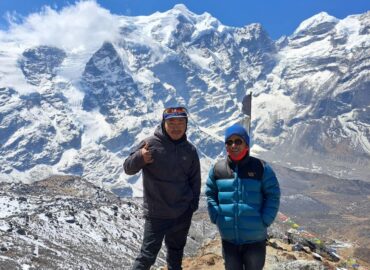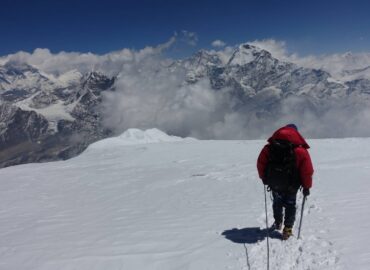- info@destinationholidaytrek.com
- +977-9768913779
- Gokarneshwor-6, Arubari, Kathmandu, Nepal
Mera Peak climbing (6476)m
About Mera Peak (6,476m)
Mera Peak stands at an elevation of 6,476 meters above sea level. The standard route requires minimal technical climbing. As the highest trekking peak in Nepal, it attracts adventurers seeking a challenging yet achievable ascent.
This peak comprises three distinct summits: Mera North (6,476m), Mera Central (6,461m), and Mera South (6,065m). Officially, the highest point, Mera North, is recognized as Mera Peak. It is situated in the Solu Khumbu region of Nepal within the Mahalangur Himalayas.
During the early 1950s, British expeditions extensively explored the Mera Peak trek, both before and after the historic ascent of Mount Everest. Renowned mountaineers such as Edmund Hillary, Eric Shipton, and George Lowe were part of these pioneering teams.
Climbing Mera Peak presents inherent risks, making favorable weather and snow conditions crucial for a safe and successful ascent. Although the climb is technically straightforward, certain areas feature crevasses that demand caution. The western and southern faces of the peak provide more challenging and technical routes, requiring advanced mountaineering skills. Despite these difficulties, the slopes rarely exceed 40 degrees, making the climb accessible to well-prepared trekkers.
Physical fitness and a strong sense of adventure are essential for this expedition. Individuals with an active lifestyle will find Mera Peak an ideal destination. A high level of endurance is necessary for both the trek to base camp and the climb itself. Training should focus on cardiovascular fitness, strength building, and endurance exercises. Additionally, mental resilience plays a vital role, as the climb can be both physically demanding and mentally taxing.
Several routes lead to the summit, each requiring varying levels of technical expertise. The northern route is best suited for trekkers with limited mountaineering experience. In contrast, the western and southern ascents are significantly more challenging, catering to seasoned climbers.
The most common approach to Mera Peak follows the Zwatra La Pass, located at an altitude of 4,610 meters. This route offers breathtaking views of ancient villages rich in culture and tradition. The longer duration of this trek allows climbers to acclimate properly and become familiar with the terrain. The standard northern route involves glacier walking at high altitudes, while the west and south faces present more technically demanding climbs.
Why climbing mera peak?
1. Highest Trekking Peak in Nepal
At 6,476 meters, Mera Peak is the highest trekking peak in Nepal, giving climbers a true Himalayan mountaineering experience without extreme technical difficulty.
2. Panoramic View of Five 8,000m Giants
From the summit, you can see Everest, Lhotse, Makalu, Cho Oyu, and Kangchenjunga — a rare and breathtaking 360° Himalayan panorama.
3. Perfect for First-Time Climbers
Mera Peak is ideal for those taking their first step into mountaineering. It requires basic climbing skills but is considered non-technical for most of the route.
4. Safe & Gradual Climbing Route
The approach through Hinku Valley offers a slow, natural acclimatization process, reducing altitude risks and making the climb safer.
5. Remote Wilderness Experience
The trail passes through untouched forests, traditional Sherpa villages, and high-altitude glaciers, giving a true sense of adventure and solitude.
6. Achievement of a Lifetime
Standing on a 6,000+ meter summit is a huge personal achievement, perfect for adventure lovers looking to challenge themselves.
7. Training Step for Higher Peaks
Mera Peak is the best preparation climb for Island Peak, Lobuche Peak, Ama Dablam, and even future 8,000m expeditions.
Trip Highlights
1. Summit Mera Peak (6,476 m), one of the highest trekking peaks in Nepal
2. Experience Sherpa culture in Solukhumbu and Hinku Valley
3. Stunning views of Everest, Makalu, Lhotse, Cho Oyu, and other Himalayan giants
4. Trek through remote villages, rhododendron forests, and high alpine landscapes
5. Professional climbing guide and full support team
Trip overview



☀️ Best Season: March–May & September–November
🏁 Start Start Point: Kathmandu
🎯 Ending point : Lukla
ITINEARY
- Activities: Airport pickup, hotel transfer, trip briefing.Overnight: Hotel in Kathmandu.
- Flight time: 30 mins / Trek: 4-5 hrsDescription: Scenic flight to Lukla, then descend through forest and cross small ridges to reach Paiya.
Overnight: Teahouse/Lodge.
- Trek time: 5-6 hrsDescription: Ascend through forest, cross Kari La Pass, and reach the Sherpa village of Panggom.
Overnight: Teahous
- Trek time: 5-6 hrsDescription: Walk through rhododendron forests, climb and descend ridges with mountain views.
Overnight: Teahouse.
- Trek time: 6-7 hrsDescription: Enter the Makalu Barun National Park, trek along the jungle trail.
Overnight: Teahouse.
- Description: Follow the Hinku River, enjoy views of Mera Peak, and walk through bamboo and pine forests.Overnight: Teahouse
- Trek time: 3-4 hrsDescription: Gentle walk along riverbank with views of Mera Glacier and Mera Peak.
Overnight: Teahouse.
- Trek time: 3-4 hrsDescription: Steep ascent with panoramic views, reach the base area of Mera Peak. Begin acclimatization.
Overnight: Teahouse.
- Activities: Climb a nearby ridge or hike to Mera La for acclimatization.Description: Rest, check gear, practice with climbing equipment.
Overnight: Teahouse.
- Trek time: 5-6 hrsDescription: Trek over Mera La (5,415m), then continue to High Camp with breathtaking Himalayan views.
Overnight: Tent (camping).
- Climbing time: 10-12 hrs (Summit & return)Description: Early morning summit push. Gradual ascent on rope and crampons. Enjoy 360° views (Everest, Makalu, Lhotse, Kanchenjunga). Descend to Khare.
Overnight: Teahouse.
- Purpose: Backup for summit attempt or weather delays.Overnight: Teahouse.
- Trek time: 6-7 hrsDescription: Retrace steps down through forests along the Hinku Valley.
Overnight: Teahouse.
- Trek time: 6-7 hrsDescription: Climb up through rhododendron forests and ridges.
Overnight: Teahouse.
Trek time: 6-7 hrs
Description: Cross Zatrwa La Pass with final views of the Himalayas and descend to Lukla.
Overnight: Teahouse.
Flight time: 30 mins
Description: Morning flight to Kathmandu. Rest or explore the city.
Overnight: Hotel.
Cost Includes
✔️ Airport Transfers
– Pick-up and drop-off at Tribhuvan International Airport by private vehicle.
✔️ Hotel Accommodation in Kathmandu
– 2–3 nights in a standard hotel in Kathmandu with breakfast (twin-sharing).
✔️ Domestic Flights
– Kathmandu–Lukla–Kathmandu or Ramechhap–Lukla–Ramechhap round-trip flight tickets.
✔️ Lodging During the Trek
– Tea-house accommodation during trekking days (twin-sharing).
– Camping accommodation at High Camp during summit night with all equipment.
✔️ Meals on the Trek
– 3 meals per day: Breakfast, Lunch & Dinner (tea/coffee included).
– Freshly prepared meals at High Camp by the climbing crew.
✔️ Climbing Permit & Entry Fees
– Mera Peak Climbing Permit
– Makalu Barun National Park Entry Fee
✔️ Professional Guide & Climbing Sherpa
– Licensed, experience
English-speaking trekking guide.
– Certified climbing Sherpa (1 Sherpa per client for summit day).
– All their salaries, equipment, insurance, meals, and accommodation.
✔️ Porter Services
– Fixed ropes, climbing ropes
– Tents, cooking equipment
– Ice screws, snow bars, carabiners
(Personal climbing gear not included unless you provide)
✔️ Meals & Accommodation for Staff
– All expenses for guides, Sherpa, and porters covered (food, lodging, insurance, salary).
✔️ Safety Equipment
– First aid kit
– Oximeter
– Emergency oxygen (if included in your company policy)
– Satellite phone (pay per use if necessary)
✔️ Company Service Charges
– Trekking agency service fee
– Tax & government VAT
✔️ Certificate of Achievement
– Mera Peak Climbing successful completion certificate.
Cost Exclude
1.International Airfare
Flights to and from Nepal are not included.
Personal Trekking & Climbing Gear
Down jackets, trekking boots, gloves, crampons, ice axes, harnesses, sleeping bags, and other personal gear.2.Personal Trekking & Climbing Gear
3.Hot Showers & Snacks
Hot showers during the trek (paid separately at tea houses)
Snacks, energy bars, chocolate, tea/coffee, and drinks not included.
Tips / Gratuities
Tips for guides, porters, and other staff. (Optional but customary
Travel & Health Insurance
Personal travel insurance covering medical evacuation and high-altitude trekking is mandatory but not included in the cost.
Personal Expenses
- Laundry, phone calls, Wi-Fi, souvenirs, shopping, or other personal purchases.
Emergency Evacuation
Costs for helicopter evacuation or emergency flights, if needed, are not included.
Extra Accommodation / Meals
Any extra nights Khmandu or Lukla due to weather delays or flights cancellations.
